Industry-Sponsored Student Capstone Projects
2022/2023
In the 2022/23 academic year the industry capstone program was supported by 56 sponsors and 99 real-world projects. Nearly five hundred and fifty students from across the College of Engineering participated. Scroll down to learn more about each project.Intel
Platform Architecture Optimization Using Insights from Analysis of User and Processor Data
This student team worked to study the trend of web-based apps and its impact on client resource utilization based on DCA classification of web-usage categories. This included detailed Analysis of web-based Computing Trends: In-browser, Progressive Web Apps (PWA), and Electron-based. As web technologies evolve and computations migrate more freely between the cloud & client, this student team worked to study: - Growth over time of web categories (DCA already has the browser usage data) - Client resource utilization and change over time - Client system execution characteristics over time (e.g., context switch rate) - Computational demands over time - Are apps becoming more or less demanding of the client? - What aspects of computations are changing most?
IonQ
Characterizing and Optimizing Quantum Gates
As-built quantum computers are rapidly reaching the point where they can no longer be simulated classically. However, they are held back by imperfections in their control and coupling to noisy environment. This project aims to explore links between our ability to characterize and optimize the dynamics of a quantum system to achieve a desired outcome (a quantum gate). Designing high-quality quantum gates is challenging since extreme precision is required to achieve fault-tolerance. While progress has been made in open-loop control, recent progress by Goldschmidt, DuBois, Brunton, and Kutz (https://arxiv.org/abs/2201.05266) suggests that closed-loop control techniques such as model predictive control might be beneficial. The work attempted here sought to combine these techniques with cutting-edge quantum characterization, generalizing them to quantum gate generation. This project focused on boosting the fidelity of one- and two-qubit gate operations. We considered trapped ions as our prototypical system, but the information theoretical framework we used was general. The students worked with leading quantum computing subject matter experts at IonQ around framing the control problem and demonstrating fidelity improvements based on model predictive control (or similar). If numerical results were promising, the scope worked to include experimental demonstration as well.
Jamestown S’Klallam Tribe, Environmental Planning Program
Jamestown S’Klallam Tribe Community Resiliency Center
The Olympic Peninsula has limited electrical transmission capacity, limited on-peninsula repair crews, and disaster-vulnerable landscapes and populations, resulting in poor electrical reliability and susceptibility to long duration power outages. This student team worked to explore the cost and capabilities of a renewable energy generation & storage microgrid to make the Jamestown S’Klallam tribe's tribal community center a resiliency hub that keeps critical communications infrastructure live while supporting other community needs during long duration power outages. This student team worked to build off of prior analysis staff at the Washington Clean Energy Testbeds have performed to support the microgrid Seattle City Light recently completed at the Miller Community Center and Snohomish County PUD recently built in Arlington. Microgrids for community resiliency are a growing area for engineering design. An advisory group helped guide the technical and community elements of all three microgrid projects on the Olympic Peninsula. Desired outcomes this student team worked towards include a final engineering report that: (1) Describes the context for the study, including a statement of the community resiliency goals and metrics based on community input, and the data sources available for estimating the electrical loads in the community center, solar and wind energy potential of the site, and other environmental factors (site hazards, fuel availability, etc.) (2) Applies community priorities and engineering principles to determine microgrid infrastructure needs and costs to support the highest priority loads under several discrete operational scenarios, for example, outages occurring in summer vs winter, and for islanded operation of days, weeks, or months (following a catastrophic disaster). (3) Detailed technoeconomic analysis of a base case design, including engineering drawings, site analysis, component lists and estimated pricing, with performance informed by real time digital simulation of the renewable grid operated over a typical one year period at the site. A stretch goal for this project that the student team could work toward is exploring alternative cases, such as considering the role of bidirectional charging of mobile resiliency units the Tribe has funding to purchase.
Jefferson County Department of Emergency Management
Microgrids for Community Resiliency on the Olympic Peninsula
Poor electricity reliability and slow restoration of power is an everyday issue for residents of the Olympic Peninsula, but FEMA suggests that the civilian response time for a significant regional event (e.g., major Cascadia fault earthquake) will be from 3 months to one year, with an expectation that the population be prepared for self-sufficiency during that period. The Jefferson County Department of Emergency Management is concerned about their reliance on fossil fuel back-up generators to support the department, sheriff, and 911 centers, and worked with a student team to explore the cost and capabilities of a renewable energy generation & storage microgrid for long duration power outages. This student team worked to build off of prior analysis staff at the Washington Clean Energy Testbeds have performed to support the microgrid Seattle City Light recently completed at the Miller Community Center and Snohomish County PUD recently built in Arlington. Microgrids are a growing area for engineering design. An advisory group helped guide the technical and community elements of all three microgrid projects on the Olympic Peninsula. Desired outcomes this student team worked towards including a final engineering report that: (1) Describes the context for the study, including a statement of the resiliency goals and metrics based on DEM staff input, and the data sources available for estimating the electrical loads, solar and wind energy potential of the site, and other environmental factors (site hazards, fuel availability, etc.) (2) Applies DEM priorities and engineering principles to determine microgrid infrastructure needs and costs to support the highest priority loads under several discrete operational scenarios, for example, outages occurring in summer vs winter, and for islanded operation of days, weeks, or months (following a catastrophic disaster). (3) Detailed technoeconomic analysis of the base case design, including engineering drawing, component lists and pricing estimates, with performance of the design evaluated using real-time digital simulation.
Johnson & Johnson
Using Cloud Connectivity to Automate Robotic Surgery Case Preparation
Assume a central database knows the procedure schedule, the operating surgeon, the patient, their health information, and more. How can this data be used to automate tasks, provide relevant information, and help the surgeon prepare for a robotically assisted case?! This student team worked to identify pain points within a surgeon’s journey. After identifying pain points, students were to design a multi-touchpoint experience that utilizes case, surgeon, and patient data to improve the pre-op experience. The primary user in this project is the surgeon. However, other stakeholders may include patients, circulating nurses, sterile assists, scrub techs, and other OR staff. This student team worked to accomplish the following outcomes: - Research documentation with summarized outcomes - Journey map with identified pain points - High-Fidelity prototypes - Video/Multimedia assets (where applicable) - Process documentation (including sketches, wireframes, etc.) - Presentation (including what next steps might be)
Kestra Medical Technologies
ASSURE Wearable Defibrillator Failure Investigation Lab: Process Improvements
Kestra Medical's mission is to provide innovative, intuitive medical technologies to protect and support at-risk patients. In 2021, Kestra received pre-market approval (PMA) from the FDA for an innovative new Wearable Cardioverter Defibrillator (ASSURE WCD) and is now on market and rapidly growing with distribution across the US. The ASSURE WCD is a prescription medical device that protects patients at high risk of Sudden Cardiovascular Death (SCD), often following cardiac events such as Myocardial Infarction. It is designed to be reliable, discreet and comfortable and components are re-used between patients. Kestra is responsible for assessing the WCD's performance in the field, investigating any failures and identifying opportunities for improvement. As systems reach end of life or experience faults or failures, they are returned to the Kestra Failure Analysis lab for investigation. This student team worked to create a detailed process map of the ASSURE failure analysis workflow and will work to identify methods of organizing the investigation process. Additionally, this student team sought to design a storage and cataloging system to archive items being investigated. Anticipated outcomes this student team worked towards included: -A defined process workflow of the important failure analysis process. -Insight into the best ways to apply resources and technology to improve response time. - A physical organization system for hardware under investigation. -Interfacing and collaborating with a team of skilled students and exposure to new engineering skills. Potential experience for the student team included: -Hands on work with an innovative medical device company. -Team ownership of a real-world engineering challenge, with a direct impact to saving lives of at-risk medical patients. -Exposure to medical device hardware and reconditioning processes.
King County Metro
Developing a Modeling System Designed to Predict Metro’s Bus Arrival Time
This student team worked to develop statistical models for travel time/arrival prediction on one or multiple bus routes for King County Metro (KCM) and also to implement the developed models on the subject routes. On-time-performance is the key performance indicator for a transit route. A reliable and efficient, low-latency prediction model will help to achieve better predictability for travel times along transit routes, which will provide much better customer satisfaction for KCM transit users. A predictable travel time/arrival prediction model will also help customers to confidently plan their transit trips that may connect to other modes of transportation (such as rail, water or micro-transit services). In addition, better implementation of the model will help the controllers in Transit Control Center to plan reduced idling times, which in essence may help to reduce air pollutants in the greater Seattle area and improve environmental sustainability. Outcomes this student team worked towards included: 1) a statistical module (includes mathematical formulas, parameter values, and Python programs), 2) implementation guidelines and test results of the model on the subject routes. The deliverables the student team worked toward were meant to include all the design and development documentation, test cases, and an implementation manual.
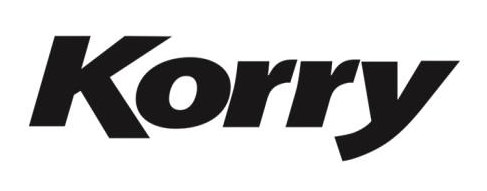
Korry Electronics
Ruggedized Haptic Feedback Touchscreens for Aerospace Applications
Touchscreens in aerospace cockpits have been established for many years, following the consumer trend experience of smart phones and tablets. However, an adoption barrier for both usability and safety considerations has been the "in turbulence, at night, during an emergency" scenario. Aerospace grade touchscreens currently provide no tactile feedback and also require visual attention on the surface. Industry and academic research has explored various approaches to haptics via various transducers. Korry believes these technologies can be integrated into existing display and bezel designs to provide presence detection before touch, and force feedback both of position within screen and confirmation of touch intent. This student team worked to research and select a tactile feedback method that works to meet these goals, taking into consideration the aerospace application requirements, and then work to integrate that into an existing display module demonstrator. The student team then attempted to run the demonstrator integrating the feedback mechanism through a series of human factors evaluations to attempt to confirm usability, reliability, and reduction in pilot workload. Desired outcomes this student team worked towards included better understandings of the benefits and limitations of the current state of the art and the ability to demonstrate to Korry's customers future capabilities in this area that improve aircraft systems safety, usability, and user experience. Anticipated deliverables this student team worked towards included a brief trade study of haptics technologies and design trades, along with the decision criteria for the selected approach. Any selected implementation produced would then be prototyped and integrated with an existing Korry touchscreen display. Finally, the student team worked to confirm the effectiveness of the prototyped technology and identify areas for future research through human factors evaluations.
Latécoère
Accumulation of Elastic Energy Using Glass Composite
Emergency systems require to be autonomous in energy. One way to store energy is to maintain elastically deformed adequate structure. This student team worked to address this problem by working to develop a specific structure composed of C spring made from glass fiber / epoxy composite. This student team also worked to develop a light and reliable way of storing mechanical energy while remaining possible to produce at low cost and at high rate. Anticipated deliverables for this project included: - A design proposal - A stress validation. - Coupon test evidence. - RC estimation - Weight evaluation - Investment's evaluation - Risk assessment at the end of the project

Lockheed Martin
JetRacer Soccer League
This project was a second year continuity of the JetRacer Soccer League project. This student team worked to utilize artificial intelligence to train RC vehicles to play competitive soccer. In the previous year, hardware was developed along with preliminary development of image recognition and object following. For this year, this student team worked to focus on improving the soccer playing capabilities of the vehicle through machine learning including striking a ball into a goal from a variety of positions on the field and showing logic capabilities for edge cases. A part of this also included the student team working to develop a simulation environment for the JetRacer to train. After demonstrating a 1 vs. 0 soccer scenario, the student team then worked to add a second agent to play 1 vs. 1 soccer. Ultimately, this work attempted to provide insights in to the use of machine learning in a competitive environment while giving the students industry exposure to project management and development. The outcomes that this student team worked to accomplish included: (1) An updated open source guide uploaded to GitHub that explains how to recreate the artificially intelligent vehicles capable of playing soccer and contains build instructions for the soccer arena plus any support equipment, (2) Development of machine learning structure to train the vehicles, (3) Up to four JetRacer vehicles with operational sensors and software, (4) Simulation and experimental data acquired throughout the project, (5) A documented summary of the results of the work and objectives achieved.

Membrion
Mining Wastewater Treatment With Novel Ceramic Ion Exchange Resins
This student team set out to investigate the use of ceramic ion exchange resins for use in mining wastewater treatment. Mining and the resulting materials play a critical role in our everyday lives; but mining generates enormous volumes of water waste. All too often, this waste is stored or abandoned instead of treated, leaving open the opportunity to contaminate valuable water streams in the future. This student team will work to investigate how ceramic ion exchange resins could add value to mining wastewater treatment by extracting heavy metals (specific elements TBD). Ceramic materials offer certain advantages over traditional polymeric resins, such as stability in low pH and stiffer networks less likely to compress under pressure. Bench-top experiments in mining-relevant conditions will guide product development to tackle this environmental problem. The outcomes this student team worked towards included lab-scale data on ion exchange capacity and regeneration efficiency under varying conditions that compares Membrion's resin to commercial resins.
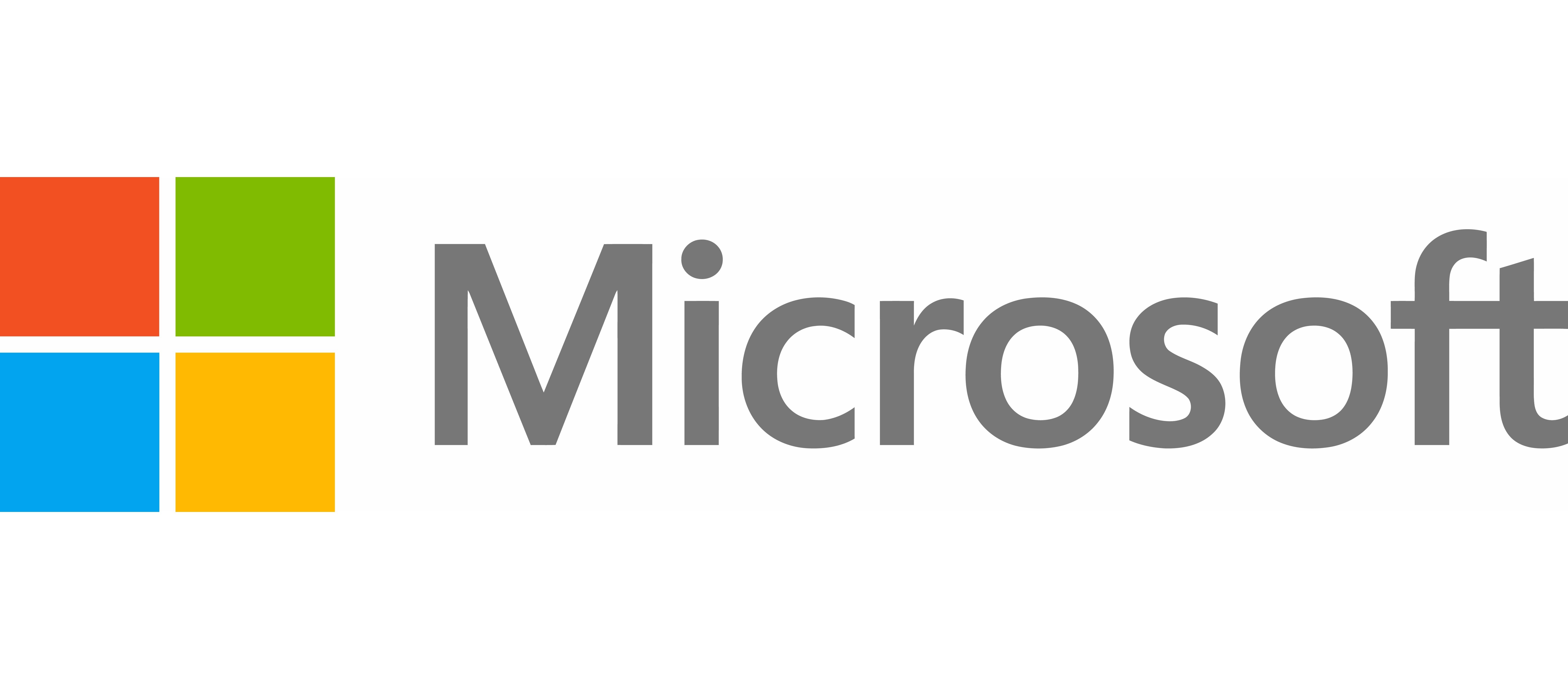
Microsoft
Integrate Automatic Oracle Synthesis into QDK for Resource Estimation
This project aimed to make quantum programming easier by automatically compiling classical code in Q# into quantum-equivalent operations in QIR for subsequent use with Azure Quantum Resource Estimation. One barrier to using automatic resource estimation tools is the requirement for a scalable quantum algorithm as input. Few scalable applications are readily available to download, and it is not easy to write them from scratch. Automatic oracle synthesis is one way to lower this barrier and works well for applications that have a large classical part, e.g., optimization algorithms on top of Grover search. For these the most difficult part is to implement the classical oracle that is used in the Grover Iteration. Since these oracles describe classical functions, one can leverage automatic so-called oracle synthesis algorithms that given a classical description of the function generate a quantum operation. Some of the techniques even allow to take objective functions into account and can yield various implementations which allow for a design space exploration.

Microsoft
Quantum Resource Estimation of Arithmetic Primitives
This project aimed to investigate the quantum computational resources needed for arithmetic primitives such as addition, multiplication, and exponentiation for integers and/or reals in floating point notation. This student team looked at the various primitives that are described in the quantum computing literature and set to analyze their efficiency in terms of the quantum resources that are needed to execute them in a fault tolerant manner. The resource estimation framework that was to be used is the one described in "Assessing requirements to scale to practical quantum advantage" by Michael E. Beverland, Prakash Murali, Matthias Troyer, Krysta M. Svore, Torsten Hoefler, Vadym Kliuchnikov, Guang Hao Low, Mathias Soeken, Aarthi Sundaram, and Alexander Vaschillo, 2022, arxiv.2211.07629. When possible the analysis used the Resource Estimation tool available on Azure Quantum. The primary scope of the project was to investigate the algorithms and circuits that already exist in the literature. The project also attempted to look at potential improvements on the existing results. The main outcome of the project was intended to be a comprehensive and consistent overview of the quantum resources needed to implement arithmetic primitives using a realistic fault tolerant quantum architecture. This overview seeks to give a better quantitative understanding of how the quantum algorithms for these primitives have improved over the past 25 years.
MilliporeSigma
Assurance GDS Kit Packaging Redesign for Sustainability
MilliporeSigma is making sustainability a priority and is looking for any avenues to improve our company's/products' environmental impact. One of MilliporeSigma's flagship products for the Food Safety industry is the Assurance GDS test kits for pathogen detection. Recent education into sustainable practices has brought awareness to the waste incorporated in traditional shipping packaging. Reducing packaging/shipping waste can have significant, compounding reduction in waste. The GDS test kit packaging has been selected for improvement. MilliporeSigma would like the help of UW students to work to improve the sustainability to the Assurance GDS packaging by reducing waste. This student team worked to develop and demonstrate proof-of-principle of a viable solution for GDS test kit package redesign, show package testing (drop testing, etc) , and provide predictive models for sustainability improvements, cost differences, reduced carbon footprint, etc.
NanoString
Deep Learning-Based Localization for RNA Spatial Transcriptomics
Nanostring spatial molecular imaging platform (SMI) leverages single molecule hybridization-based sequencing chemistry to spatially profile expression of 1000+ genes at single cell and sub cellular resolution across tissue samples. The current RNA localization algorithm relies on commonly used methodologies where potential target locations are segmented from raw images and fit with a function that approximates a point spread function. While efficient and fast, this method will fail in the multi-emitter regime. Due to the desire to increase plexity and/or use reduced codesets, it is critical to evaluate other localization schemes that are designed for densely packed data. DECODE is a state-of-the-art deep learning-based approach that enables high precision localization microscopy in dense images. This student team worked to deliver modified DECODE modules that are tailored towards high density SMI samples. The student team also worked to develop models with adequate consideration towards compensating raw data that has highly variable background and large signal dynamic ranges and outperforms standard localization methods in SMI data by an order of magnitude with respect to density, defined as having a Jaccard index >~70%. The student team also worked to provide a Python module to enable 3D clustering of localizations to find the best fit Z-plane to allow for code matching via Nanostring’s matching module.
Related News
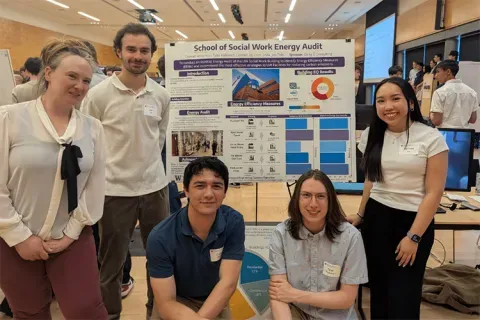
Mon, 10/13/2025 | UW Mechanical Engineering
Capstone collaboration leads to award
An ME capstone team received first place for its energy audit of the UW School of Social Work building.
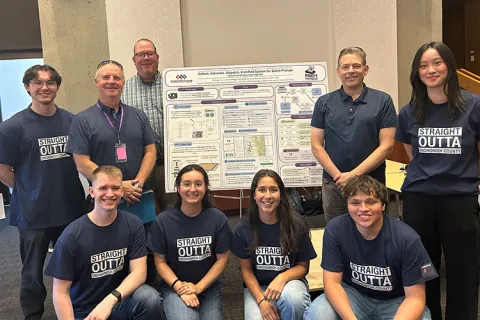
Thu, 07/17/2025
UW engineering students develop smart ballot solution
UW engineering students develop smart technology solution to improve ballot collection for Snohomish County.
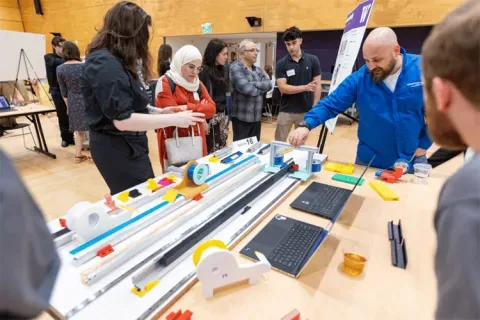
Mon, 07/07/2025 | UW Mechanical Engineering
Capstone creations
Students displayed innovative capstone design projects at the 2025 expo.

Fri, 09/20/2024 | UW Civil & Environmental Engineering
Smarter irrigation for a greener UW
A new project combines satellite data with ground sensors to conserve water and create a more sustainable campus environment.